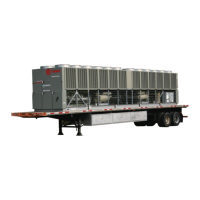RLC-SVX02G-E4
64
Maintenance Procedures
6. Take extra care to properly
maintain all service equipment
that directly supports
refrigeration service work, such
as gauges, hoses, vacuum
pumps, and recycling equipment.
7. Stay aware of unit enhancements,
conversion refrigerants,
compatible parts, and
manufacturer’s recommendations
that will reduce refrigerant
emissions and increase
equipment operating efficiencies.
Follow the manufacturer’s
specific guidelines for conversion
of existing systems.
8. In order to assist in reducing
power-generation emissions,
always attempt to improve
equipment performance with
improved maintenance and
operations that will help conserve
energy resources.
Refrigerant and Oil-Charge
Management
Proper oil and refrigerant charge is
essential for proper unit operation,
unit performance, and
environmental protection. Only
trained and licensed service
personnel should service the chiller.
Some symptoms of a refrigerant
under-charged unit:
• Low subcooling
• Bubbles in the EXV sight glass
• Low-liquid-level diagnostic
Refrigerant Emission
Control
Conservation and emission
reduction can be accomplished by
following recommended Trane
operation, maintenance, and service
procedures, with specific attention
to the following:
1. Refrigerant used in any type of
air-conditioning or refrigerating
equipment should be recovered
and/or recycled for reuse,
reprocessed (reclaimed). Never
release refrigerant into the
atmosphere.
2. Always determine possible
recycle or reclaim requirements of
the recovered refrigerant before
beginning recovery by any
method.
3. Use approved containment
vessels and safety standards.
Comply with all applicable
transportation standards when
shipping refrigerant containers.
4. To minimize emissions while
recovering refrigerant, use
recycling equipment. Always
attempt to use methods that will
pull the lowest possible vacuum
while recovering and condensing
refrigerant into containment.
5. Refrigeration-system cleanup
methods that use filters and
dryers are preferred. Do not use
solvents that have ozone
depletion factors. Properly
dispose of used materials.
• Larger-than-normal evaporator
approach temperatures (Leaving-
Water Temperature - Saturated
Evaporator Temperature)
• Low Evaporator-Refrigerant
Temperature Limit
• Low Refrigerant-Temperature
Cutout diagnostic
• Fully-open expansion valve
• Possible whistling sound coming
from liquid line (due to high vapor
velocity)
• Possible low discharge superheat
at high loads
• High Condenser + Subcooler
Pressure drop
Some symptoms of a refrigerant
over-charged unit:
• High subcooling
• Evaporator Liquid Level higher
than centerline after shutdown
• Larger-than-normal condenser
approach temperatures (Entering-
Condenser Saturated Temperature
– Entering-Air Temperature)
• Condenser Pressure Limit
• High-Pressure Cutout diagnostic
• More-than-normal number of fans
running
• Erratic fan control
• Higher-than-normal compressor
power
• Very low discharge superheat at
startup
• Compressor rattle or grinding
sound at startup
